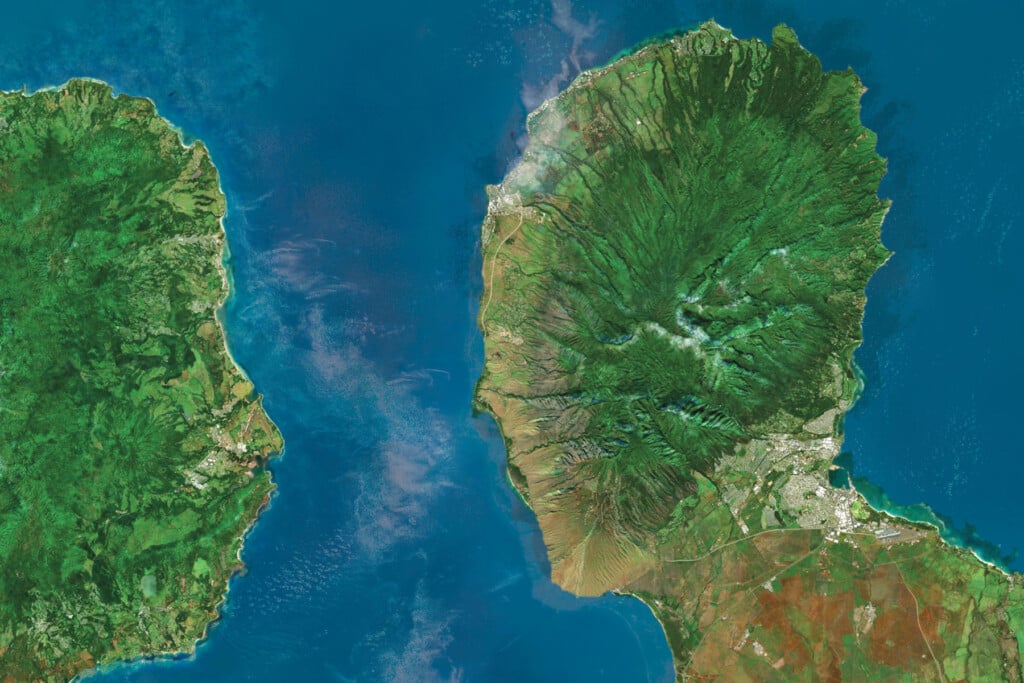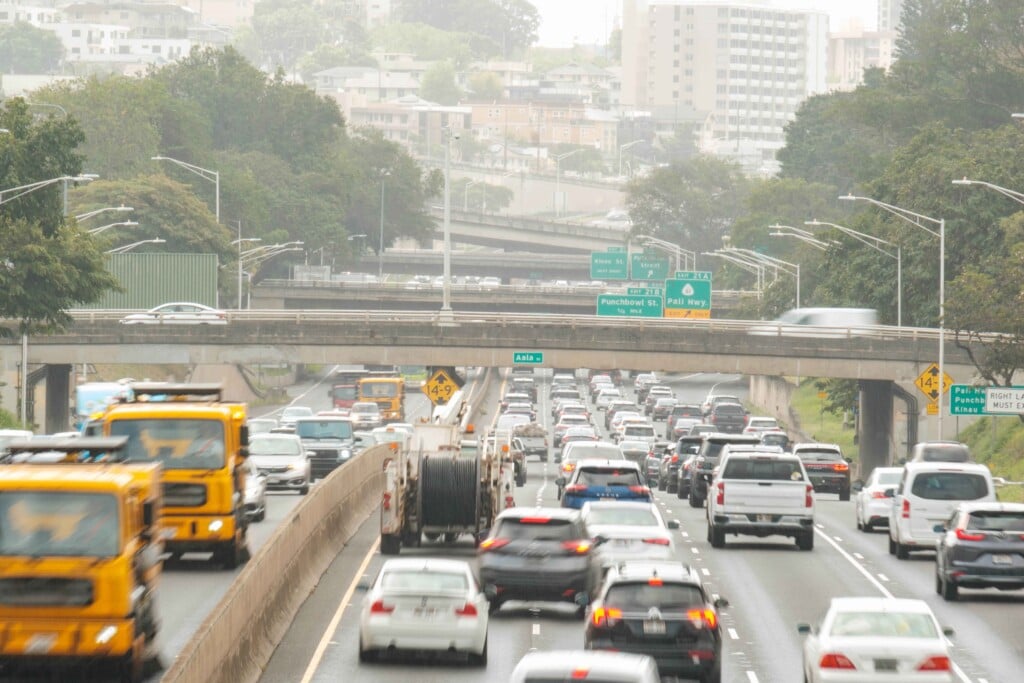Hawai‘i Foodbank Has a New Model for Feeding 120,000 People a Month
President and CEO Amy Miller Marvin says, “We’ve completely changed our sourcing. It allows us to be more thoughtful about nutrition.”

Amy Miller Marvin, president and CEO of Hawai’i Foodbank, says 1 in 4 children in Hawai‘i are food insecure – meaning they don’t have the consistent access to food they need to lead active healthy lives. She talks about how the Foodbank is transforming the way it collects and distributes food to better serve those who need it.
This interview has been condensed.
How many people does Hawai’i Foodbank serve in an average month?
About 110,000 people on O‘ahu and 10,000 people on Kaua‘i, including people coming multiple times to a food pantry and those who need help just once at the end of the month when their SNAP benefit runs out.
And we partner with the Maui Food Bank and The Food Basket on Hawai‘i Island. We’re a member of Feeding America, a network of about 200 food banks nationwide that gives us access to donated and heavily discounted food, so we can pass those benefits to Maui and the Big Island.
Who is the typical person you serve?
It runs the gamut – all walks of life – but since the pandemic began, we’ve seen lots of people need help for the first time. At least a third of those we support are employed – sometimes two jobs – yet can’t make ends meet.
We estimate 1 in 6 people in Hawai‘i are now food insecure. That includes about 1 in 4 children – the second-highest rate of childhood food insecurity in the country after Louisiana. Kūpuna in multigenerational households are more likely to be food insecure than kūpuna living alone. We think one reason is grandparents might go without to be sure a grandchild has enough to eat. No one should ever have to make that choice.
What does food insecurity mean?
It means there isn’t regular consistent access to food for everyone in the household to lead an active healthy life. It could mean you have access to food, but not healthy food. It could be someone on SNAP has healthy food for the first three weeks but not all month. It might mean a parent goes without.
Many times kids get healthy meals at school – maybe breakfast and lunch – but not another healthy meal until they come back to school. That makes weekends and school breaks especially difficult.
How does Hawai’i Foodbank counter food insecurity?
The Foodbank does little direct distribution. Almost all of the food is distributed through about 200 partners, ranging from small country churches to large nonprofit food pantries. We gather food for those partners.
Retailers, wholesalers, manufacturers, farmers donate products and our trucks pick up food daily and bring it to the warehouse.
Nonperishable items are simple: We have storage space for that. Produce is complicated because most produce sold in Hawai‘i has been on a ship for a week and then on display in the store. When it gets to the Foodbank, it often needs to be consumed quickly. But food safety is critical, so every donated item is inspected by a trained volunteer or staff member.
Another 15% of our food comes from the USDA’s emergency food program, which buys food from farmers on the continent. The rest of our food we buy.
Prior to the pandemic, we were purchasing little: Our annual food purchase budget was about $400,000. But the pandemic blew up that model, because need more than doubled and our regular sources of food fell because shoppers cleaned out retailers and people weren’t going to restaurants and kids weren’t going to school. So retailers and restaurants had little to donate.
We pivoted to purchasing. We averaged about a million dollars a month in food purchases during the pandemic and that model remains. This fiscal year, we budgeted to spend $8.7 million on purchases.
That’s 20 times your pre-pandemic spending on purchased food.
Yes, we’ve completely changed our sourcing. It allows us to be more thoughtful about nutrition. Another silver lining from the pandemic is we partnered with the Hawai‘i Farm Bureau, which represents farmers who suddenly lost their primary customers – hotels and restaurants.
We’ve continued that program. It’s a win-win-win: supporting local agriculture; investing in local food systems; and getting fresh, healthy produce that can last a couple of weeks in your fridge. Last year, 32% of the food we distributed was fresh produce.
Canned goods and other non-perishables will always be an important part of what we do. But we know many food insecure people are at high risk of chronic health issues related to nutrition and expensive produce can be the first thing eliminated if you need to cut costs.
What are your special programs for the most vulnerable populations: keiki and kūpuna?
We’re piloting a program where about 2,200 low-income seniors across O‘ahu and Kaua‘i get a monthly box of USDA foods and we add an 8- to 10-pound bag of produce.
For keiki, we have a school pantry program in 37 schools, where kids get access to a healthy snack during the day and for the weekends, they can take home a 5-pound bag of food. That’s something we’d like to expand.
We have a summer program, when kids don’t have access to school meals, so they can still have a hot meal during the day. Last year, we were in eight sites.
How do you describe your revised mission?
Our new mission is: We nourish our ‘ohana today and work to end hunger tomorrow. In partnership with others, we address the systemic reasons people need our services. Can we put people in contact with other resources so we can shorten the food pantry line?
One pillar is to get qualified people access to federal SNAP benefits. We got a contract from the state, so we have outreach coordinators and translation services at distribution sites. It’s hard and complicated to get SNAP benefits and that’s why 15% or more of people eligible for SNAP aren’t getting access.
Another issue: An emergency pan-demic addition to SNAP benefits will probably expire in February. About 91,000 families across the state get an average of $199 of those additional benefits a month.
What does the Foodbank need more: donated food or donated money?
If you purchase food to donate to us, it’s inefficient, because we can provide 2.15 meals for every dollar donated. You can’t buy 2.15 meals for $1 but we can. So we’re encouraging people to donate money to the Foodbank instead of going to the store to buy food to donate. We can stretch money so much further and we have a better sense of what foods are needed. For instance, if we get a container of carrots or of ground beef from the mainland, we pivot to buy other things.
But if you have things in your cupboard that you don’t use or you have extra fruit from a tree, we’ll take that any day. (Donate or volunteer at hawaiifoodbank.org.)
What about volunteering?
There’s a ton of ways to volunteer and it can be a lot of fun. We have volunteer opportunities every day sorting food at the warehouse (2611 Kilihau St. in Mapunapuna). It’s also a great team-building activity. And we help our partners get volunteers too. (Last year, volunteers worked 23,892 hours.)
What did you recently change in your cost-sharing system?
We and most food banks charged a “shared maintenance fee” to partners – like 9 or 18 cents per pound of food – to share the cost of transportation, distribution, storage and all that. Food we buy on a grant is 100% free for the agencies, but if we’re purchasing food on unrestricted dollars, we pay half and they pay half.
That’s how I think 98% of food banks worked pre-pandemic. But the agencies that tended to get the most food had the most money or the staff to visit the Foodbank daily, not necessarily the organizations serving the most vulnerable communities. A small church group might literally pass the hat to pay a $30 maintenance fee.
That’s a barrier we did not want our agencies to face, so we eliminated the fee in April and reduced the shared cost of purchases to 25%. Our goal is to get that to zero while we build a more equitable food distribution model.
How do you learn about the people you serve so you can serve them better?
Every time someone goes to a food distribution, they sign up and we ask a few questions – just the bare minimum. Some partners provide great reports and others 50 pages of handwritten sign-in sheets because they lack the technology.
We’re piloting a new system that we’ll eventually ask all our agencies to use. The client only signs up once. When you’re in our system, you get a QR code on your phone or a card with a QR code. You can go to any partner and scan your code. That will let us better understand who we’re serving and when.
Maybe someone goes to a pantry by their home, but there’s no cold storage there for produce, so they go much farther for produce. We can work on those problems, but we don’t know those things now.
This database will let us ask a few more questions over time. Does someone in the family have health conditions that require a special diet or low-sodium food we can supply at that distribution site?
Or we learn people need rental assistance and we ask Catholic Charities if they can set up a table at this distribution point.
You mentioned a partnership with mainland food banks. How does that help Hawai‘i?
We’re working with the Feeding America research team to look at food insecurity rates by ZIP code. We’re doing a good job of getting food to every corner of the island, but we also know some ZIP codes have many more people who are food insecure. So how are we getting enough food to those ZIP codes? And maybe there’s a pantry where you live, but it’s only open Wednesday mornings, and you work then. Do we need another partner in that area? Does an agency there need more volunteers or a refrigerator to store produce? So we are trying to better understand what it takes to meet the needs, then build a plan to meet those needs.
Matson has been an incredible partner, covering the cost to bring containers here from the mainland. We’ve been kind of adopted by some food bank consortiums on the West Coast. We’re talking to a guy at Feeding the Northwest – it’s a cooperative of all the food banks in Idaho, Washington, Oregon – and he asks, “Do you guys ever want apples? Because, sometimes all the food banks in the Northwest are like, ‘No more apples.’ ” So he sent us a container of apples. People love them. And then he sent us a container of gorgeous big Idaho potatoes. And then he called me, “Would you mind if I wrote a grant to send you guys at least one container of produce a month?” I said that would be lovely. And so they’ve been sending onions, carrots, things that really last.
California Association of Food Banks adopted us too. We got this gorgeous load of celery and super-low-cost navel oranges. We’re able to just bring in food we’ve never had before, thanks to the partnership with Matson and a focus on, “What are the needs?” as opposed to “Where is the supply right now?” It’s a pivotal change in how we work.
We’re also working with our agency partners on education: Teaching people to incorporate healthier choices into their repertoire.






